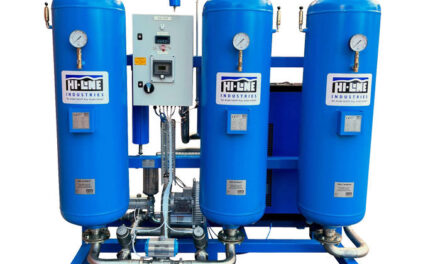 To ensure hydraulic systems work safely, reliably and effectively, not only is it essential to specify the correct products for the application, but also to monitor their condition throughout their use. Nigel Ord, general manager of fluid power at ERIKS, explains
To ensure hydraulic systems work safely, reliably and effectively, not only is it essential to specify the correct products for the application, but also to monitor their condition throughout their use. Nigel Ord, general manager of fluid power at ERIKS, explains
Despite hydraulic systems being seen as dirty, with leaking fluid resulting in contamination and a threat to health and safety, the hose technology available today means modern systems can actually be virtually leak-free.
Ensuring hydraulic hoses and systems remain leak-free, however, relies on the need for regular checks and preventative maintenance, with a robust programme of hose maintenance including not only visual checks but also taking advantage of some of the latest automated hydraulic hose condition monitoring equipment.
Monitoring
One example available for this is Sentry IQ, developed by Gates. This monitors real-time diagnostic information about the operating condition and performance of hose assemblies, continuously measuring temperatures, pressures, impulse cycles and more to calculate remaining hose life and identify when replacement is needed before failure occurs. Maintenance can then be carried out during a planned shutdown. Such tools are a valuable safety net for critical applications, such as mining and offshore rigs.
If there are any suspicions that the hose did not serve out its expected lifespan then it is important to establish if a replacement is capable of meeting application conditions.
A proactive hose replacement programme will address such issues.
An hydraulic monitoring system cannot, however, warn of damage caused by abrasion, abuse, climate or other external conditions, so regular on-site inspection is essential to identify hose assemblies that are beginning to crack, blister and bubble. The tell-tale signs of impending failure are cracked or corroded fittings; damaged or abraded hose covers; kinked, flattened or twisted hoses; and leaks at fittings or on the hose itself.
To ensure that the hydraulic hose is functioning internally, the system should be operated at maximum pressure to check for possible malfunctions and leaks. However, the hydraulic assembly must be approached with caution as a jet of hydraulic fluid from a pinhole leak can penetrate the skin.
An effective way to prevent failure from occurring in the first place is to pay attention to the minimum bend radius of the hose, as it is stress on the wire braiding that often causes catastrophic failure. While hoses are typically subject to abrasion in the presence of aggressive substances, some are now available that can offer 25 more times more resistance than international standards demand. If correct installation is carried out using a hose specified to cope with a tight bend radius, such as Gates’ Megasys constant pressure range of hose, it is far easier to pipe-up applications, not to mention cheaper, since there is less hose to install.
Ensuring safety and reliability
Hydraulic systems need to be correctly specified, installed and maintained to ensure safety and reliability, and that contamination and hazards such as leakage are reduced.
Some of the latest automated hydraulic hose condition monitoring, diagnostic and fault detection equipment mean not only improved safety but that uptime and productivity can also be maximised.
With its skills and expertise in hydraulics, ERIKS can help with hydraulic product specification, as well as repair and refurbishment. It can also offer everything needed to ensure the statutory compliance and safe operation and maintenance of hydraulic systems.
ERIKS UK
T: 0121 508 6219

